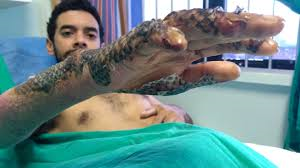Brazil settled for fish skin to save pain for burn victims
People catch fish to eat or watch, with the latter case limited to some aquarium fish. Brazilian doctors have recently added one more use – treating burn patients.
According to international journals, physicians in Fortazela, Brazil, cover burn patients with fish skin, or more correctly “sterilized tilapia,” which helps patients recover at a much faster rate.

Doctors in Fortezela are testing the skin of a common fish as a bandage for second or even third-degree burns. In other countries, including the United States, doctors used the animal skin, including pig skin, in the treatment of burns, or human skin if there are donors.
Brazil, which lacks in human skin and pig skins as artificial skin substitutes, has come up with an answer utilizing one of the most common resources it has.
Traditional bandage needs constant replacement, often causing pain and discomfort for patients. Fish skin lasts long, saving these troubles and pains.
The first aquatic animal skin in the world tested in burn patients is “tilapia,” a fish widely farmed in Brazil. Tilapia skins are plentiful as fish farms throw them away, considering it as trash. The sterilized tilapia skin stays until the patient scars naturally, which takes nine to 11 days on average.
“We got a great surprise when we saw that a lot of collagen proteins, -- types 1 and 3 that are crucial for scarring -- exist in large quantities in tilapia skin, even more than in human skin and other skins,” said Dr. Edmar Maciel, one of the plastic surgeons who developed the treatment said. “Another factor we discovered is that the amount of tension, of resistance in tilapia skin, is much greater than in human skin and the amount of moisture.”
Making them into a sterile, odorless medical dressing requires multiple steps. It’s sterilized in chlorhexidine, which is an antiseptic, then in glycerol in various concentrations. Afterward, they send it to Sao Paulo for complementary radiosterilization, which is the only way to ensure the skin is sterilized against viruses.
Antônio dos Santos, a fisherman, accepted the tilapia treatment as part of a clinical trial after he sustained burns to his right arm when a gas canister on his boat exploded.
“After they put on the tilapia skin, it relieved the pain,” he said. “I thought it was fascinating that something like this could work.”
The treatment is now in clinical trials. So far there are 52 patients in the study, and none have presented complications.
Researchers confirmed the skins are cost-effective and environmentally beneficial and Dr. Maciel is hoping the treatment will enter the national health system after more testing.
In Brazil, in addition to the clinical trials, researchers are conducting histological studies that compare the composition of human, tilapia, pig, and frog skins. They are also conducting studies on the comparative costs of tilapia skin and conventional burn treatments. If clinical trials show continued success, doctors hope a company will process the skins on an industrial scale and sell it to the public health system.

